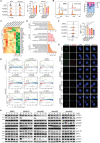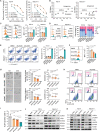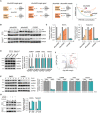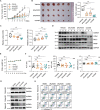A Temporal PROTAC Cocktail-Mediated Sequential Degradation of AURKA Abrogates Acute Myeloid Leukemia Stem Cells
- PMID: 35652200
- PMCID: PMC9353462
- DOI: 10.1002/advs.202104823
A Temporal PROTAC Cocktail-Mediated Sequential Degradation of AURKA Abrogates Acute Myeloid Leukemia Stem Cells
Abstract
AURKA is a potential kinase target in various malignancies. The kinase-independent oncogenic functions partially disclose the inadequate efficacy of the kinase inhibitor in a Phase III clinical trial. Simultaneously targeting the catalytic and noncatalytic functions of AURKA may be a feasible approach. Here, a set of AURKA proteolysis targeting chimeras (PROTACs) are developed. The CRBN-based dAurA383 preferentially degrades the highly abundant mitotic AURKA, while cIAP-based dAurA450 degrades the lowly abundant interphase AURKA in acute myeloid leukemia (AML) cells. The proteomic and transcriptomic analyses indicate that dAurA383 triggers the "mitotic cell cycle" and "stem cell" processes, while dAurA450 inhibits the "MYC/E2F targets" and "stem cell" processes. dAurA383 and dAurA450 are combined as a PROTAC cocktail. The cocktail effectively degrades AURKA, relieves the hook effect, and synergistically inhibits AML stem cells. Furthermore, the PROTAC cocktail induces AML regression in a xenograft mouse model and primary patient blasts. These findings establish the PROTAC cocktail as a promising spatial-temporal drug administration strategy to sequentially eliminate the multifaceted functions of oncoproteins, relieve the hook effect, and prevent cancer stem cell-mediated drug resistance.
Keywords: Aurora kinase A (AURKA); E3 ubiquitin ligase; PROTAC cocktail; acute myeloid leukemia stem cells.
© 2022 The Authors. Advanced Science published by Wiley-VCH GmbH.
Conflict of interest statement
The authors declare no conflict of interest.
Figures







References
-
- Marumoto T., Zhang D., Saya H., Nat. Rev. Cancer 2005, 5, 42. - PubMed
-
- Huang X.‐F., Luo S.‐K., Xu J., Li J., Xu D.‐R., Wang Li.‐H, Yan M., Wang X.‐R., Wan X.‐B., Zheng F.‐M., Zeng Y.‐X., Liu Q., Blood 2008, 111, 2854. - PubMed
-
- Tanaka T., Kimura M., Matsunaga K., Fukada D., Mori H., Okano Y., Cancer Res. 1999, 59, 2041. - PubMed
-
- Ewart‐Toland A., Dai Qi, Gao Y.‐T, Nagase H., Dunlop M. G., Farrington S. M., Barnetson R. A., Anton‐Culver H., Peel D., Ziogas A., Lin D., Miao X., Sun T., Ostrander E. A., Stanford J. L., Langlois M., Chan J. M., Yuan J., Harris C. C., Bowman E. D., Clayman G. L., Lippman S. M., Lee J. J., Zheng W., Balmain A., Carcinogenesis 2005, 26, 1368. - PubMed
Publication types
MeSH terms
Substances
Grants and funding
- 81820108024/National Natural Science Foundation of China
- 8217112502/National Natural Science Foundation of China
- 81872440/National Natural Science Foundation of China
- 81972594/National Natural Science Foundation of China
- 81773166/National Natural Science Foundation of China
- 81630005/National Natural Science Foundation of China
- 2022A1515010915/Natural Science Foundation of Guangdong
- 2017A020215098/Natural Science Foundation of Guangdong
- 2017A030313608/Natural Science Foundation of Guangdong
- 2018A0303130299/Natural Science Foundation of Guangdong
- 2020JJ25CY008/Science and Technology Innovation Foundation of Dalian
- SZBL2021080601001/Shenzhen Bay Laboratory Research Funds
- 2019YFA0110300/National Key R&D Program of China
- 2017YFA0505600-04/National Key R&D Program of China
- 201804020044/Science and Technology Planning Project of Guangzhou
- 19ykpy187/Central Universities
LinkOut - more resources
Full Text Sources
Medical
Miscellaneous
